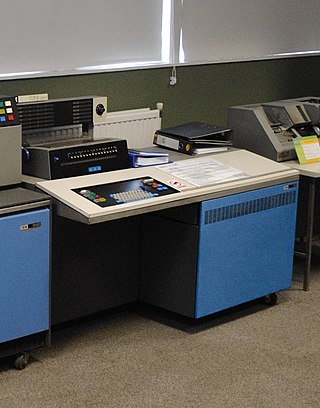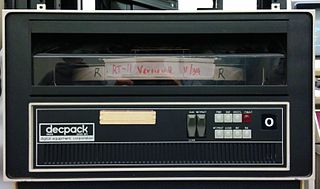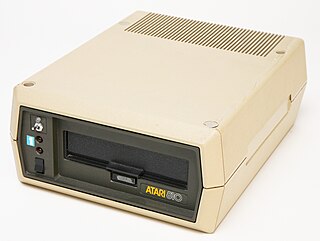
The Commodore 1541 is a floppy disk drive which was made by Commodore International for the Commodore 64 (C64), Commodore's most popular home computer. The best-known floppy disk drive for the C64, the 1541 is a single-sided 170-kilobyte drive for 5¼" disks. The 1541 directly followed the Commodore 1540.

A floppy disk or floppy diskette is a type of disk storage composed of a thin and flexible disk of a magnetic storage medium in a square or nearly square plastic enclosure lined with a fabric that removes dust particles from the spinning disk. Floppy disks store digital data which can be read and written when the disk is inserted into a floppy disk drive (FDD) connected to or inside a computer or other device.

A hard disk drive (HDD), hard disk, hard drive, or fixed disk, is an electro-mechanical data storage device that stores and retrieves digital data using magnetic storage with one or more rigid rapidly rotating platters coated with magnetic material. The platters are paired with magnetic heads, usually arranged on a moving actuator arm, which read and write data to the platter surfaces. Data is accessed in a random-access manner, meaning that individual blocks of data can be stored and retrieved in any order. HDDs are a type of non-volatile storage, retaining stored data when powered off. Modern HDDs are typically in the form of a small rectangular box.

Digital Equipment Corporation (DEC)'s PDP-10, later marketed as the DECsystem-10, is a mainframe computer family manufactured beginning in 1966 and discontinued in 1983. 1970s models and beyond were marketed under the DECsystem-10 name, especially as the TOPS-10 operating system became widely used.

In computing, booting is the process of starting a computer as initiated via hardware such as a button or by a software command. After it is switched on, a computer's central processing unit (CPU) has no software in its main memory, so some process must load software into memory before it can be executed. This may be done by hardware or firmware in the CPU, or by a separate processor in the computer system.

Drum memory was a magnetic data storage device invented by Gustav Tauschek in 1932 in Austria. Drums were widely used in the 1950s and into the 1960s as computer memory.
OS/8 is the primary operating system used on the Digital Equipment Corporation's PDP-8 minicomputer.
In computer science, group coded recording or group code recording (GCR) refers to several distinct but related encoding methods for representing data on magnetic media. The first, used in 6250 bpi magnetic tape since 1973, is an error-correcting code combined with a run length limited (RLL) encoding scheme, belonging into the group of modulation codes. The others are different mainframe hard disk as well as floppy disk encoding methods used in some microcomputers until the late 1980s. GCR is a modified form of a NRZI code, but necessarily with a higher transition density.
Modified frequency modulation (MFM) is a run-length limited (RLL) line code used to encode data on most floppy disks and some hard disk drives. It was first introduced on hard disks in 1970 with the IBM 3330 and then in floppy disk drives beginning with the IBM 53FD in 1976.

The IBM 1130 Computing System, introduced in 1965, was IBM's least expensive computer at that time. A binary 16-bit machine, it was marketed to price-sensitive, computing-intensive technical markets, like education and engineering, succeeding the decimal IBM 1620 in that market segment. Typical installations included a 1 megabyte disk drive that stored the operating system, compilers and object programs, with program source generated and maintained on punched cards. Fortran was the most common programming language used, but several others, including APL, were available.
IBM manufactured magnetic disk storage devices from 1956 to 2003, when it sold its hard disk drive business to Hitachi. Both the hard disk drive (HDD) and floppy disk drive (FDD) were invented by IBM and as such IBM's employees were responsible for many of the innovations in these products and their technologies. The basic mechanical arrangement of hard disk drives has not changed since the IBM 1301. Disk drive performance and characteristics are measured by the same standards now as they were in the 1950s. Few products in history have enjoyed such spectacular declines in cost and physical size along with equally dramatic improvements in capacity and performance.

DECtape, originally called Microtape, is a magnetic tape data storage medium used with many Digital Equipment Corporation computers, including the PDP-6, PDP-8, LINC-8, PDP-9, PDP-10, PDP-11, PDP-12, and the PDP-15. On DEC's 32-bit systems, VAX/VMS support for it was implemented but did not become an official part of the product lineup.

Cylinder-head-sector (CHS) is an early method for giving addresses to each physical block of data on a hard disk drive.
The Massbus is a high-performance computer input/output bus designed in the 1970s by Digital Equipment Corporation (DEC). The architecture development was sponsored by Gordon Bell and John Levy was the principal architect.

Digital Equipment Corporation's RK05 is a disk drive whose removable disk pack can hold about 2.5 megabytes of data. Introduced 1972, it is similar to IBM's 1964-introduced 2310, and uses a disk pack similar to IBM's 2315 disk pack, although the latter only held 1 megabyte. An RK04 drive, which has half the capacity of an RK05, was also offered.

In computer disk storage, a sector is a subdivision of a track on a magnetic disk or optical disc. For most disks, each sector stores a fixed amount of user-accessible data, traditionally 512 bytes for hard disk drives (HDDs) and 2048 bytes for CD-ROMs and DVD-ROMs. Newer HDDs use 4096-byte (4 KiB) sectors, which are known as the Advanced Format (AF).
Patterned media is a potential future hard disk drive technology to record data in magnetic islands, as opposed to current hard disk drive technology where each bit is stored in 20–30 magnetic grains within a continuous magnetic film. The islands would be patterned from a precursor magnetic film using nanolithography. It is one of the proposed technologies to succeed perpendicular recording due to the greater storage densities it would enable. BPM was introduced by Toshiba in 2010.
The floppy disk is a data storage and transfer medium that was ubiquitous from the mid-1970s well into the 2000s. Besides the 3½-inch and 5¼-inch formats used in IBM PC compatible systems, or the 8-inch format that preceded them, many proprietary floppy disk formats were developed, either using a different disk design or special layout and encoding methods for the data held on the disk.

The Commodore D9060/D9090 Hard Disks were the only family of hard drives that Commodore made for both the home and business market. The electronics are identical in the D9060 and the larger D9090 unit; the only difference is the size of the installed hard drive, with a jumper set to distinguish between 4 or 6 disk heads. Originally intended for the metal-cased PET/CBM series of computers, they are compatible with the VIC-20, Commodore 64 and later models with an adapter.

Frequency modulation encoding, or simply FM, is a method of storing data that saw widespread use in early floppy disk drives and hard disk drives. The data is modified using differential Manchester encoding when written to allow clock recovery to address timing effects known as "jitter" seen on disk media. It was introduced on IBM mainframe drives and was almost universal among early minicomputer and microcomputer floppies. In the case of floppies, FM encoding allowed about 80 kB of data to be stored on a 5+1⁄4-inch disk.












